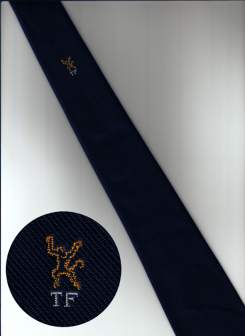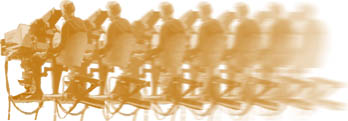
From Roger Bunce, Memories of Z Cars
My earliest memories of “Z Cars” are of watching it at home when I was a teenager.
It had the reputation of being a hard-hitting, down-to-earth drama. But, being
broadcast live, it was prone to technical cock-ups which sometimes provided unintentional
humour. Scenes inside the Z Car were shot in the studio with back-projection screens
outside the car windows. Mistiming of the back-projection was a common cause of
cock-ups. I remember once seeing the street scene suddenly disappear from the
rear window, to be replaced by a flashing “10 – 9 – 8 etc.” telecine countdown.
On another occasion P. C. Lynch was riding in the passenger seat. The dialogue
had reached the point where the car should have stopped so that he could alight.
But the back-projected scenery was still travelling past at speed. As he opened
the door and stepped out, Jimmy Ellis improvised the desperate line, “Don’t
bother to stop. I’ll jump for it.”
The 100th episode of “Z Cars” was particularly full of cock-ups. As a home viewer,
I got the impression that they had made the mistake of holding the celebratory party
before the transmission. One shot showed Stratford Johns walking along a corridor
with a very visible camera dolly following him all the way. The cameraman was turning
in concern to his tracker. This was shortly before a figure in headphones went
scampering across the foreground. It says much for the standard of the script and
performances that all these technical errors did little to reduce the dramatic
impact of the episode. When P. C. Sweet died at the end, I still cried.
In 1965 I joined the BBC as a trainee cameraman and, in the years that followed I
found myself working on “Z Cars” in the BBC’s Riverside Studios at Hammersmith.
The programme was no longer broadcast live but it was recorded as though it were live,
in one continuous performance. At that time the cost of video tape editing was prohibitive.
My main memory of these studio sessions is that the cast were constantly larking about.
I remember Jimmy Ellis (I think he was Sgt. Lynch by then) delivering a serious address
to his men, while wearing a back-to-front balaclava, and the others were struggling
to keep straight faces. One of our camera crew once brought in a plastic police
helmet, truncheon and whistle set, which he had found in a toy shop. This was
immediately seized by the cast. For the rest of rehearsals, whenever as actor
appeared in a doorway he would be wearing the helmet, swinging the truncheon
and talking through the whistle.
While all this playfulness was great fun, it was sometimes frustrating for an inexperienced
cameraman, like myself, who was still struggling to get his shots right. Just occasionally
it would have been nice to have a sensible rehearsal with actors in the correct positions
and speaking the correct dialogue.
I remember one difficult shot which I particularly needed to rehearse. It started with a
close-up of P. C. Bannerman (Paul Angelis) inside the Z Car. He was watching out for a
suspect. With a sudden cry of, “There he goes!” he would leap out of the car and give
chase. My camera had to crane up and track backwards rapidly, in order to cover his
movement, taking care not to get hit by the opening door. Such was the speed and
abruptness of the move that it was difficult enough just to keep the actor in
frame and in focus. But there was an added complication in that the studio Z
Car was just the sawn-off middle section of a car. It had no bonnet, no glass
in the windscreen, etc. As I hurtled backwards and my shot widened I had to
ensure that only the believable parts of the Z Car were visible in the background.
Timing and positions were critical, both for the camera and the actor. I had
had problems with the shot during early rehearsals. Now it was the final
run-through, my last chance to get it right before recording. I set up
the opening of the shot, my lens poking through the side window of
the Z Car. I braced myself ready for a rapid pull back as the door
was thrown open. Tension mounted as the dialogue cue approached.
It came. “There he goes!” cried P. C. Bannerman and, pointing dramatically,
he stepped straight forward through the windscreen!
So, I never did get my sensible rehearsal.
And more, from Mike Cotton
No, the party for the 100th Z Cars wasn't before the show! David Rose (the producer)
decided to direct the 100th himself, but if the little grey cells are working,
the telecine links between each scene had gone down (or was this during the
episode with Eric Barker, who was inexperienced in TV matters and he had to
be hurried, bewilderedly, between sets by the call boy, as they were known in
those days). Indeed on the 100th behind every door that was opened there lurked a camera.
The jolly japes on the pre rehearsal day, which didn't usually extend into the 2nd day,
included Frank entering in a Tu Tu, having his raincoat tied to the hatstand - he exited
the scene hatstand and all! There were some actors who were afraid of the regulars,
Toke Townley was always the butt for Brian Blessed, who on one occasion during a 'siege'
at a cottage rained clods of earth down on any one daft enough to get in range.
For all that the cast were very professional - they understood that a boom took a finite
time to swing and with a quiet word, would delay lines until it arrived (they realised
they wouldn't be heard otherwise). Alan (Stratford Johns) would take immense pains
with inexperienced actors, coaching and rehearsing when off camera. We got our
reward when he lost his voice on transmission and the boom operators had to favour
him all the time whilst avoiding those pesky shadows and wide shots. We had a great
trusting relationship with the vision mixers, they knew we would clear the wide
shot before they had to take it and with very few exceptions, we knew they would
cut as rehearsed or if things changed, they would always give us warning. When
Eric Monk was lighting, at the first hint of a shadow there he would be saying
"that'll be all right" and it always was.We worked as a team so long that a
slight movement of a cameraman's head would indicate the head room, but they
would always compromise as would the directors The pedal controlled Vinten
caused much hilarity - Arthur Sutton? got confused with the pedals and was
elevating out of control and trying to pan into a flat as he almost fell
off the camera, saying "I'm sorry" repeatedly.
And from me, Softly Softly
Softly Softly, when I worked on it, was recorded, but the producer, Len Lewis,
always hoped that we'd be
allowed to do it live “next week or the week after”. So we would record at exactly
the time that last week's recording was being transmitted. We would go straight
through no matter what, and if the producer and director were happy, we'd be in
the bar by nine thirty. Sometimes we would do re-takes for BBC Enterprises - sale
abroad - and they would presumably pay to cut edit the tape.
Softly was always fun. The actors, many of the directors, and the crew worked together
for many weeks. The senior members of the cast - Alan Stratford-Johns, Frank Windsor
and Norman Bowler - were big on practical jokes and would sometimes give a director
or new actor a hard time. Most of the jokes were on each other, though. Frank always
carried a brief case as Inspector Watt, and a regular trick was to put a scene weight
in it, so that when he picked it up to make an exit, it was much heavier than expected.
Each season included a new young copper for the regulars to play off. One season it was
Gavin Campbell, later to be seen on That's Life. A regular part of the studio set was
a car without a windscreen in front of a huge back-projection screen. Early in the
series, Norman and Gavin had a scene in the car, “driving along”. The scene crew
explained to Gavin during rehearsal that if he pressed the (manual) windscreen
washer button, Norman, who had been sending Gavin up quite a lot, would be
soaked. Of course Norman had set this up, so that when Gavin pressed the button,
he was the one who was soaked. Later on, they came back to the car and the
scene crew explained that they thought the actors were in the opposite seats,
and this time they'd got it right. Gavin pressed the button again, and of course
was soaked again.
Come the recording everyone was always a total pro. And all the actors were also excellent
craftsmen, always hitting their marks, and timing.
Somewhere I have a set of my camera shot cards from the show.
I kept them because they are unusual in that a good proportion of the shots say
BCU Barlow. One particular director, David Sullivan Proudfoot, liked to have a lot
of shots in the show, maybe over six hundred rather that the usual three hundred.
As a junior I more often dragged cables or drove camera cranes than actually
pointing a camera. So this set of cards was worth keeping to the 21 year old me.
I wished I had saved a lot more.
From Peter Neill A Softly Softly Task Force tie



